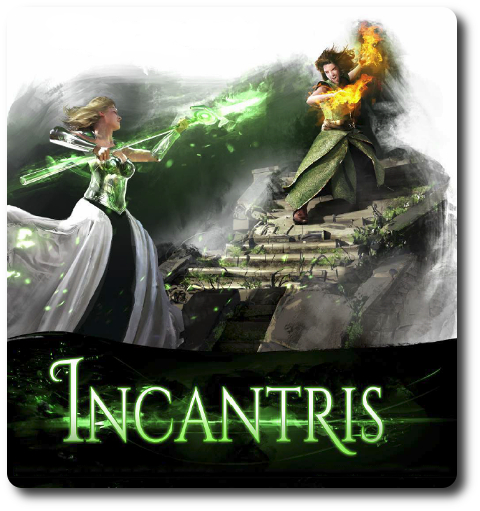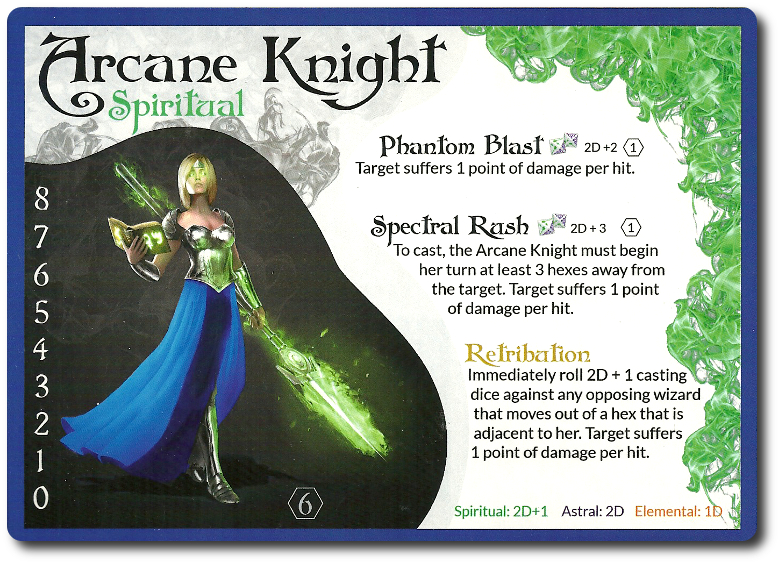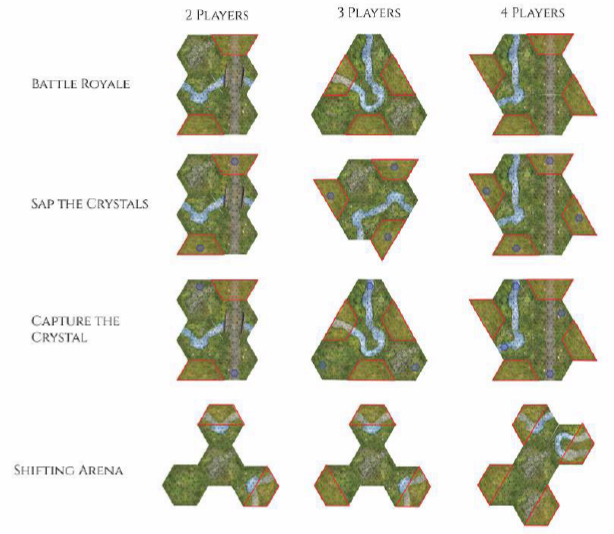Please Take Note: This is a review of the final game, but it might change slightly based on the success of the Kickstarter campaign. The game is being reviewed on the components and the rules provided with the understanding that “what you see is not what you might get” when the game is published. If you like what you read and want to learn more, we encourage you to visit the game publisher’s website or visit the Kickstarter campaign. Now that we have all that disclaimer junk out of the way, on with the review.

The Basics:
- For ages 7 and up (publisher suggests 14+)
- For 2 to 4 players
- Approximately 60 minutes to complete
Geek Skills:
- Active Listening & Communication
- Counting & Math
- Logical & Critical Decision Making
- Reading
- Strategy & Tactics
- Risk vs. Reward
- Visuospatial Skills
- Bluffing and Misdirection
Learning Curve:
- Child – Easy
- Adult – Easy
Theme & Narrative:
- Test your magical might on the battlefield
Endorsements:
- Gamer Geek approved!
- Parent Geek approved!
- Child Geek approved!
Overview
They say there is nothing magic cannot do. This might be true, but magic does have its limitations. Magic is only as powerful as the one who wields it. There are those who walk this world who know power, but they are not yet truly powerful. This is about to change…
Incantris, designed by Seth Robinson, Heath Robinson, and to be published by RAINN Studios, will reportedly be comprised of 8 double-sided hexagonal grid tiles, 4 double-sided half-hexagon tiles, 12 Wizard miniatures (2 Shamans, 2 Shadow Weavers, 2 Druids, 2 Sorcerers, 2 Sorceresses, and 2 Arcane Knights, in four different colors), 12 Wizard Reference boards, 12 Wizard Turn tokens, 12 Life Point sliders, 5 custom eight-sided Casting dice, and a various number of cardboard terrain representing trees, walls, ruins, spell effects, and other battlefield obstacles. As this is a review of prepublished game, I cannot comment on the component quality. What was provided shows a great deal of emphasis on making the game look as good possible to strengthening the game’s play and thematic nature. Two of the miniatures to be produced were provided as examples.

Prepare for the Challenge
To set up the game, first allow each player to build a team comprised of 3 Wizards, taking the matching Wizard miniatures, Life Point sliders, Turn tokens, and Reference boards. Spell Effect tiles associated with the Wizards should be claimed at this time, as well. Teams should all be the same color. Selection of teams should not be done hastily, as each Wizard has a specialty that translates to a special tactic or strategy that can be used on the battlefield. For example, the Red Team (comprised of the Shaman, Druid, and Sorceress) focuses on movement control and area control spells. Return any Wizards not claimed back into the game box, along with all their associated game components. Set the Casting dice to one side of the game playing area.

Second, agree as a group on the game scenario. Scenarios will determine basic goals for each player and adjust the game play. There are 4 scenarios in the game, but more can be created by the players. The scenarios are as follows.
- Battle Royale: The default scenario where players attempt to crush their foes first.
- Crystal Sap: Players attempt to sap the energy of a crystal while battling foes at the same time.
- Capture the Crystal: Similar to Capture the Flag
- Shifting Arena: Similar to Battle Royale, but the battlefield continues to shift and morph under the Wizards’ feet.
Third, construct the battlefield (also referred to as the “Arena”). The size and shape of the battlefield is dependent on the number of players and the scenario being used. Any tile can be used, but the overall configuration must match that which is shown in the rule book. Terrain obstacles may be placed if desired.

Fourth, determine turn order by rolling the Casting dice. Then have all players place their Wizard miniatures on their starting positions.
That’s it for game set up. Time to show your skill.
The Brutality of Magic
Incantris is played in rounds and turns with no set number of rounds per game. On a player’s turn they can select only 1 inactive Wizard to control and take an action with. A player can either Move and then Cast a Spell, or Cast a Spell and then Move. Some Wizards have a Special Ability that can be used in place of Casting a Spell. Actions are always optional, but the player must activate at least 1 inactive Wizard per turn. If the player has lost a Wizard or Wizards during game play, they take no action for the turn they cannot activate a Wizard.
Movement
Movement in the game is counted by using Movement Points. Movement Points determine the total number of spaces the Wizard could travel under optimal conditions and without obstacles getting in the way, but the player is never required to use all of the Movement Points during their turn.
Most movement will only cost the player 1 Movement Point, but terrain and obstacles could force the player to spend more or even stop movement. For example, a player cannot move their Wizard miniatures through a space occupied by an opposing Wizard team miniature. Crossing streams will cost the player 2 Movement Points and trees, walls, and other obstacles are impassable.
Casting a Spell
The Wizard Reference board lists the spells that can be cast by the Wizard. When the player wants to use a spell they must first announce what spell they are using and the target. Targets can be a single hex, a single Wizard, or area effect. Then the target confirms they are in range and can be seen. Obstacles can block Line of Sight. If a line can be drawn from one hex to another without an obstruction, the Wizard can see the target.
After it has been determined that the target can be hit, the player with the active Wizard rolls the appropriate number of Casting dice. If successful, the spell is let loose on the battlefield. The target can, if they so choose, attempt to ward off the spell by countering it.
Special Abilities
All Wizards have a Special Ability that can be used instead of casting a spell or are active at all times during the Wizard’s activation. Some Special Abilities even allow Wizards to act out of turn or influence other Wizards’ actions. Use of a Special Ability is always optional, but they are available for a reason. Use them when necessary.
Damage, Death, and Destruction
Wizards will take damage during the game. Life Points are tracked on the Wizard Reference board. When a Wizard’s Life Points are reduced to zero, their miniature is removed from the battlefield and can no longer be used.
Ending the Round
The round ends after all players have activated their Wizards. A new round now begins by resetting all Wizards to “inactive”, allowing them to be used again.
Magic Domination
The game is won by successfully completing the scenario. The first player to do so wins the game.
Campaign Warfare
The game’s narrative states that the Wizards are in a dual to determine who is best suited to champion the kingdom. Four games can be chained together to match the story-line, pitting the players against each other in different Arenas and in different matches. Wizards gain experience when they remove a Wizard from the battlefield. Experience may be spent to purchase equipment. Equipment includes a Power Ring that improves dice rolls, Healing Potions, and even Winged Boots that greatly improve movement.
To learn more about Incantris, visit the game publisher’s website or visit the Kickstarter campaign.
Final Word
 The Child Geeks liked the easy game play and BIG effects that the spells had in the game. The visual representation of the battlefield, complete with hexes and standup obstacles, complemented their game playing experience and drew them in even deeper. According to one Child Geek, “The Wizards are really different. You have to treat them like they are specialists in a combat squad.” Exactly! While the game is fantasy-based, even the Child Geeks quickly recognized that what they had was a squad of specialists that were capable of very tactical and strategic actions. Another Child Geek said, “There is always something to do. I like games like this because you are never left wondering what is possible.” The simple game play allowed for some of our youngest Child Geeks to enjoy the game, while the game’s depth and speed kept the older Child Geeks engaged. The end result was a full endorsement by the Child Geeks.
The Child Geeks liked the easy game play and BIG effects that the spells had in the game. The visual representation of the battlefield, complete with hexes and standup obstacles, complemented their game playing experience and drew them in even deeper. According to one Child Geek, “The Wizards are really different. You have to treat them like they are specialists in a combat squad.” Exactly! While the game is fantasy-based, even the Child Geeks quickly recognized that what they had was a squad of specialists that were capable of very tactical and strategic actions. Another Child Geek said, “There is always something to do. I like games like this because you are never left wondering what is possible.” The simple game play allowed for some of our youngest Child Geeks to enjoy the game, while the game’s depth and speed kept the older Child Geeks engaged. The end result was a full endorsement by the Child Geeks.
 The Parent Geeks who were interested in the game’s theme found it to be a great game to play with their kids for an evening. According to one Parent Geek, “It has all the visual flare of a big miniatures game, but plays fast like Chess. It’s a great mix of tactics and fun game play.” Another Parent Geek said, “I’d play this with my kids, my friends, and anyone at a gaming convention.” What the Parent Geeks found almost instantly was the exact same thing the Child Geeks eventually caught onto. Each group of Wizards is a team that can play off each others abilities and should be used for tactical and strategic game play. All the Parent Geeks voted to approve Incantris.
The Parent Geeks who were interested in the game’s theme found it to be a great game to play with their kids for an evening. According to one Parent Geek, “It has all the visual flare of a big miniatures game, but plays fast like Chess. It’s a great mix of tactics and fun game play.” Another Parent Geek said, “I’d play this with my kids, my friends, and anyone at a gaming convention.” What the Parent Geeks found almost instantly was the exact same thing the Child Geeks eventually caught onto. Each group of Wizards is a team that can play off each others abilities and should be used for tactical and strategic game play. All the Parent Geeks voted to approve Incantris.
 The Gamer Geeks at first thought that Incantris was going to be nothing more than a Beer-and-Pretzels game. That is to say, light and loose. They were pleased to find that Incantris was a game full of depth, required tactical movement, strategic planning, and critical thinking. According to one Gamer Geek, “This reminds me of the miniatures games you can play at conventions that have the rules boiled down to the essentials. No fluff. Just enough to get the job done and have a good time.” Another Gamer Geek said, “I feel that the game is very streamlined and am very impressed with the mix of spells. Each Wizard brings something different to the table and is a lot of fun to use during the game.” The Gamer Geeks, after several games under their belt, decided to approve Incantris, finding it to be a game that not only entertained them, but was also well worth their time.
The Gamer Geeks at first thought that Incantris was going to be nothing more than a Beer-and-Pretzels game. That is to say, light and loose. They were pleased to find that Incantris was a game full of depth, required tactical movement, strategic planning, and critical thinking. According to one Gamer Geek, “This reminds me of the miniatures games you can play at conventions that have the rules boiled down to the essentials. No fluff. Just enough to get the job done and have a good time.” Another Gamer Geek said, “I feel that the game is very streamlined and am very impressed with the mix of spells. Each Wizard brings something different to the table and is a lot of fun to use during the game.” The Gamer Geeks, after several games under their belt, decided to approve Incantris, finding it to be a game that not only entertained them, but was also well worth their time.
 What separates Incantris from the rest of the many, many miniatures games available today is its ease of play and accessibility that does not reduce the game’s strategic and tactical depth. That is to say, the game’s designers appear to have made a game that is easy to learn and play without watering down the overall experience and thrill that comes from hunting down an opponent and fire-balling them out of the game. Movement is very important and so is range. Spells can reach you in hard to find places and even the best protection can quickly become a dangerous spot.
What separates Incantris from the rest of the many, many miniatures games available today is its ease of play and accessibility that does not reduce the game’s strategic and tactical depth. That is to say, the game’s designers appear to have made a game that is easy to learn and play without watering down the overall experience and thrill that comes from hunting down an opponent and fire-balling them out of the game. Movement is very important and so is range. Spells can reach you in hard to find places and even the best protection can quickly become a dangerous spot.
What I like most is the different spells and abilities. They bring the Wizard to life and quickly communicate to the player how best to approach opponents. Have a Wizard with close combat spells? Get into range and back him up with some magical protection from a Wizard who can cast spells at range. Need to nuke an opponent who is behind a tree? Send in a friendly wizard to take out the tree and then let loose hellfire. It’s all about how well you use your team of Wizards. Individually that are pretty powerful, but easy targets. Use them as a group and you have a near invincible group who can take down anything.
Well balanced, fast, fun, and oftentimes fierce, Incantris is the kind of game you bring out on the weekend and play with friends. As soon as you put it away, you look forward to bringing it out again. Whether it be a premade scenario or a fan created one, the game is always focused on survival of the fittest. However, the battlefield will be won by the smartest player, not the toughest. Do try Incantris when time allows.
This is a paid for review of the game’s final prototype. Although our time and focus was financially compensated, our words are our own. We’d need at least 10 million dollars before we started saying what other people wanted. Such is the statuesque and legendary integrity of Father Geek which cannot be bought except by those who own their own private islands and small countries.



